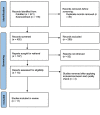Association of Major Depressive Disorder in Hyperparathyroidism: A Systematic Review
- PMID: 37425517
- PMCID: PMC10328424
- DOI: 10.7759/cureus.40150
Association of Major Depressive Disorder in Hyperparathyroidism: A Systematic Review
Abstract
Major depressive disorder (MDD) is a common neuropsychiatry manifestation that is more prevalent lately. Many contributing factors are present (for example, neurochemical, physiological, pathophysiological, and endocrinological factors). Patients with increased serum parathyroid levels are usually linked to psychosis symptoms but not to depressive symptoms. We conducted this systematic review to explore a correlation between depressive disorder and increased serum parathyroid levels, a major endocrinological pathology, and help establish mental wellness in patients suffering from hyperparathyroidism. We conducted a thorough literature search using five major databases, MEDLINE, PubMed, PubMed Central (PMC), ScienceDirect, and Google Scholar, using three keywords-MDD, depression, and hyperparathyroidism. We included mixed method studies, including observational studies, non-randomized controlled trials, case reports, and review articles published in the last ten years, focusing on the adult and geriatric population (>18 years) and on depressive and anxiety symptoms associated with patients with hyperparathyroidism. We included 11 articles (seven observational studies + four case reports) for qualitative synthesis after screening the literature. The reviewed studies showed an association between high serum parathyroid level, high serum calcium level, high serum alkaline phosphatase level, low serum phosphorous level, and increased depressive neurocognitive symptoms. After a patient with hyperparathyroidism is treated for hypercalcemia or undergoes parathyroidectomy and the serum parathyroid levels are lowered, a decrease in severe depressive symptoms is noted. The qualitative analysis of the reviewed literature showed an association between major depressive disorder and hyperparathyroidism. This paper can guide clinicians to assess patients with increased serum parathyroid levels for depressive neuropsychiatric symptoms and plan treatment, as treatment of their hyperparathyroidism can significantly lower their depressive symptoms. More randomized controlled trials should be conducted to find the treatment effectiveness of depression in patients with hyperparathyroidism.
Keywords: depression; hyperparathyroid; hyperparathyroid-induced hypercalcemia; major depressive disorder (mdd); parathyroid pathology.
Copyright © 2023, Desai et al.
Conflict of interest statement
The authors have declared that no competing interests exist.
Figures


References
-
- Depressive and anxiety disorders in patients with primary hyperparathyroidism. Kunert Ł, Gawrychowski J, Sobiś J, Buła G, Pudlo R. Psychiatr Pol. 2020;54:1091–1107. - PubMed
-
- The Associations of Serum Osteocalcin and Cortisol Levels With the Psychological Performance in Primary Hyperparathyroidism Patients. Wang SM, He Y, Zhu MT, Tao B, Zhao HY, Sun LH, Liu JM. https://doi.org/10.3389/fendo.2021.692722. Front Endocrinol (Lausanne) 2021;12:692722. - PMC - PubMed
-
- Perioperative changes in cortical excitability, mood, and quality of life in patients with primary hyperparathyroidism: a pilot study using transcranial magnetic stimulation. Hermsen A, Eienbröker A, Haag A, et al. Eur J Endocrinol. 2014;170:201–209. - PubMed
-
- Normocalcemic hyperparathyroidism and treatment resistant depression. Grønli O, Wynn R. Psychosomatics. 2013;54:493–497. - PubMed
Publication types
LinkOut - more resources
Full Text Sources
